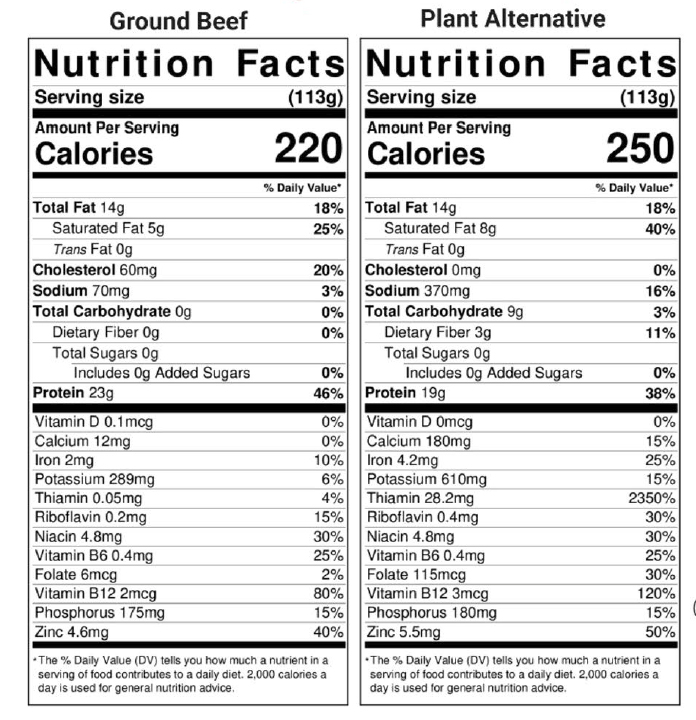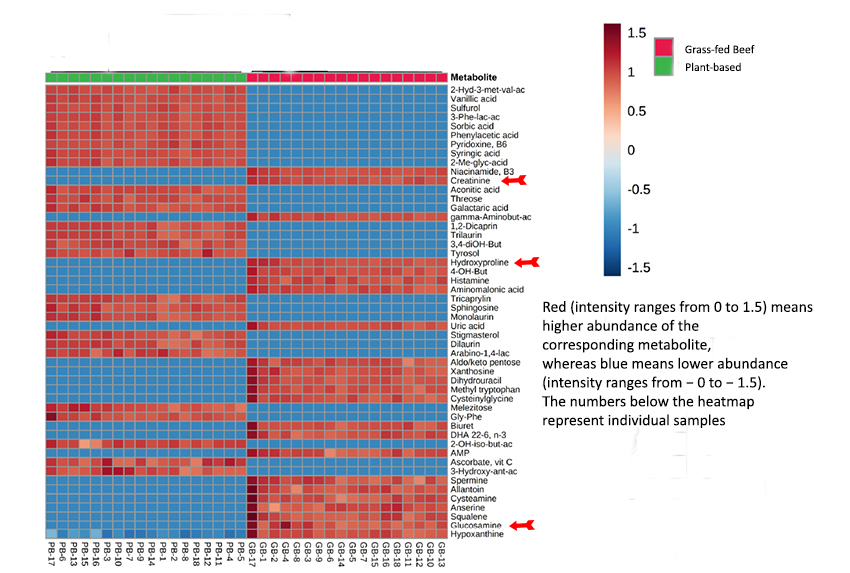“The objective of my invention is to furnish a vegetable substitute for meat which shall possess equal or greater nutritive value in equal or more favorable form for digestion and assimilation and which shall contain the essential nutritive elements in approximately the same proportion as beef and mutton and which substitute has a similar flavor and is as easily digestible as the most tender meat” (U.S. Patent No 670283A)
That quote is from the patent holder, John Kellogg, allowing us to trace back this goal over 100 years. Plant-based meat and now chicken alternatives seek to fill that role; a new study finds. (Spoiler alert, that they are not as biosimilar as we might think.) The researchers looked at two products, a plant-based "meat" (while they didn’t say it directly it was the Impossible Burger) and grass-fed beef.
The Nutritional Facts Panel

Despite an equivalent serving size, there are clear differences in the nutrients required for food labeling. [1] They differ in terms of calories, cholesterol, salt, carbohydrate, and protein content. At the micronutrient level, the plant-based alternative is enriched. I would argue that these two products have a similar nutritional profile. Even if we were to quibble over amounts, let’s, for the sake of the moment, accept them from a consumer’s point of view as nutritionally equivalent, (I will leave health, taste, and ethical considerations to the side, although they do impact our choices.)
The researchers cooked the samples as we might in making a hamburger and took samples from the results, subjecting them to a more rigorous breakdown and analysis. They looked not just at the nutrients we find on those nutritional labels but at the constituent parts. For example, they characterized the amino acids making up the proteins and the various metabolites found within both products.
A metabolomic analysis
“We found that a total of 171 out of 190 annotated metabolites (90%) were different between beef and the plant-based alternative.”
So much for being similar. At the metabolic level, one that goes unreported, meat and plants no matter how they might resemble one another in texture and taste are very different – no surprise there, is there? There were substantial differences in these foods. The researchers created a graphic, termed a heat map, to show just how different the two foods are at the metabolite level.

The constituent parts of the plant-based "meat" (the squares to the left) are completely different in amounts from those on the left, the grass-fed beef. With apologies for the small size of the text, these two products have very different components.
The researchers point out that beef has creatinine, hydroxyproline, and glucosamine, (marked with the red arrows), none of which are found in the plant-based alternative, all modulating inflammation, and immunity. Low values are associated:
“with cardiovascular, neurocognitive, retinal, hepatic, skeletal muscle, and connective tissue dysfunction."
But let your heart not be troubled. The plant-based alternative contained more tocopherols (Vitamin E) and phytosterols, not found in the beef, with a role in preventing inflammation and with “cancer-protective properties.”
The central point to be made is that our nutritional labels don’t tell the whole story, and they can lead us astray. More importantly, looking for specific properties and constituents may be a fool’s errand; both products have anti-inflammatory components, they just differ in the specifics.
Let us add one more complexity to the analysis, bioavailability. Just because a component is found in food doesn’t mean that it is digested and processed by our gut to be available to us. Iron is deficient in plant-based diets and can be supplemented. But the iron in meat is in the form of heme which is far more available than the usual iron supplement. Equivalent amounts of iron on the nutritional label do not necessarily translate into equal amounts of iron in you.
The researchers conclude that plant-based meat alternatives are not interchangeable with meat; they complement one another. Using sophisticated scientific techniques, they are reporting something we hopefully learned growing up, that you should eat a balanced, diverse diet. They also make a strong argument that our food labels are not as helpful as we had hoped in making food choices.
[1] The labels are corrected to set fat in both products to be equal.
Source: A metabolomics comparison of plant‑based meat and grass‑fed meat indicates large nutritional differences despite comparable Nutrition Facts panels Nature Scientific Reports DOI: 10.1038/s41598-021-93100-3




